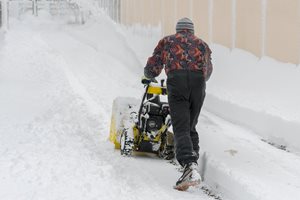(11/30/2020)
With the winter season fast approaching, healthcare facilities everywhere are not only preparing for a major drop in temperatures, but an increase in patients as well. With the COVID-19 pandemic continuing to spread and the seasonal flu about to hit its peak, millions are being impacted on a global scale by two infectious diseases at once. Healthcare facilities must be operational 24 hours a day, 7 days a week, even when facing severe weather conditions - and especially during a pandemic.

There’s no shortage of emergencies to prepare for this winter, and facilities teams are working overtime to ensure the physical healthcare environment can withstand the storm. During this cold weather season, it’s important to have plans in place to keep patients safe, warm and comfortable.
Unexpected cold weather storms can bring snow, sleet and freezing rain causing a loss of power and communication, so it’s critical to be ready for any situation. Some regions get much more snow than others, but even major cities as far south as Atlanta and Dallas have been paralyzed by harsh winter weather in recent years.
Just as the CDC’s
winter weather page recommends creating a disaster and communication plan for your family ahead of time, healthcare facilities teams must also work together to create emergency management plans to effectively handle every possible scenario. An effective emergency management plan begins with staff communication, as this is integral to determining who is able to assist during a disaster. Everyone should know their role during a crisis well in advance. Outside partners such as local, regional, state and federal response organizations, as well as vendors and other local healthcare facilities, also need to be included in the plan.
One thing facilities teams can do to stay up-to-date is to frequently monitor the
National Weather Service (NWS) for changing conditions. It’s also helpful to be aware of how to prevent cold-related health problems such as
hypothermia and frostbite, which can both be deadly and require immediate medical care.
At Medxcel facilities across the county, our teams are taking steps to avoid common cold weather hazards, such as freezing pipes or water damage. Maintenance teams should be checking their facilities’ heating systems to ensure everything is working properly to keep the building warm through the winter. The
American Red Cross suggests keeping building temperatures no lower than 55°F to prevent freezing pipes. Teams must take time too to check the roof for possible damage, which could cause major issues during heavy rain, ice storms or blizzards.
Facilities also need to have a team ready to clear snow and salt all walkways. Failing to clear sidewalks of snow and ice is a risk for fall-related injuries, which are a leading concern for the older population in nursing care facilities and hospitals. Weather-related disasters are not only dangerous, but costly. Each year, weather-related calamities lead to
approximately 500 deaths and $15 billion in damages.
Preparing for the winter forecast, along with the seasonal flu and now the global COVID-19 pandemic, can be a lot to manage. Luckily, our Medxcel healthcare facilities teams are pros at prepping for every outcome in order to keep our patients, visitors and staff warm and safe this snow season.
Want to learn more about Medxcel and our services? Contact us at
info@medxcel.com or 855-633-9235.